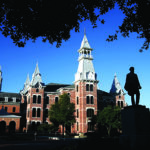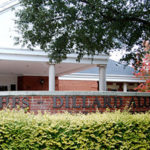WACO—Four months after Baylor University’s chief lawyer sent a letter insisting the Baylor Alumni Association “cease and desist” its use of Baylor’s licensed trademarks, the organization published an issue of the Baylor Line.
The magazine includes a lengthy cover article that purports to tell the “real story” about the longstanding dispute between the association and the university’s board of regents and administration.
 The Spring 2014 issue of the Baylor Line.“The BAA Executive Committee debated the merits of opening old wounds with a cover story that chronicles this sad history. Ultimately, we decided that it is worthwhile to provide background and context for alumni, parents, faculty and students who may have only seen or heard pieces of the story,” George Cowden III, president of the association, wrote in his column in the Baylor Line. Cowden noted the alumni association’s desire “to start a dialogue about the future” of the organization.
The Spring 2014 issue of the Baylor Line.“The BAA Executive Committee debated the merits of opening old wounds with a cover story that chronicles this sad history. Ultimately, we decided that it is worthwhile to provide background and context for alumni, parents, faculty and students who may have only seen or heard pieces of the story,” George Cowden III, president of the association, wrote in his column in the Baylor Line. Cowden noted the alumni association’s desire “to start a dialogue about the future” of the organization.
In an interview, he explained the association particularly wanted to facilitate discussion among its members and directors. The association’s annual meeting is May 31 in Waco.
“We wanted to answer the most-asked question asked by our members: How did we get to this point?” Cowden said.
The association did not publish the magazine—or select the topic for its cover story—to provoke a response from the university, he insisted.
“That was not our intent,” he said. “We don’t have any control over what Baylor does. We certainly hope there is not litigation. If Baylor initiates it, we will defend ourselves.”
The Baylor Alumni Association mailed the Baylor Line to about 17,000 households and emailed an electronic version to 18,000 recipients, he said.
 Members of the Baylor Alumni Association vote Sept. 7, 2013 on a proposal that would have terminated the 1993 license agreement, dissolved the BAA charter, and permanently terminated the Baylor Alumni Association name. It failed to gain two-thirds approval. (Baylor Line Photo)John Barry, vice president for marketing and communications at Baylor, said the association had not communicated to the university its plan to publish the issue, and the school “couldn’t possibly comment on something we don’t know anything about.”
Members of the Baylor Alumni Association vote Sept. 7, 2013 on a proposal that would have terminated the 1993 license agreement, dissolved the BAA charter, and permanently terminated the Baylor Alumni Association name. It failed to gain two-thirds approval. (Baylor Line Photo)John Barry, vice president for marketing and communications at Baylor, said the association had not communicated to the university its plan to publish the issue, and the school “couldn’t possibly comment on something we don’t know anything about.”
Sign up for our weekly edition and get all our headlines in your inbox on Thursdays
The latest issue of the Baylor Line includes a detailed timeline of events in the relationship between the Baylor Alumni Association and the university, beginning in 1978 with the association filing articles of incorporation to become a tax-exempt nonprofit organization separate from the school.
Much of the 12,000-word cover article focuses on the “disintegration” of the association’s relationship with the board of regents and administration during the latter years of Robert Sloan’s tenure as university president—particularly after Baylor created its own alumni relations office and began publishing its own magazine in June 2002.
The article quotes Stan Madden, professor of marketing and director of Baylor’s Center for Nonprofit Studies, who served as vice president for university relations before leaving that post in 2003. When Sloan asked what he would do if he wanted to “get rid of the alumni association,” Madden told the Baylor Line he said, “I would do a Microsoft.”
“What Microsoft has found is that any time they have a competent competitor who has found a market and if they can’t buy them, then Microsoft has enough money to do what the competitor does but just give it away until the competitor can’t afford to do it anymore, and then Microsoft can control the market,” Madden said, according to the magazine article.
 Former Baylor University president Robert Sloan was advised to “Microsoft” the Baylor Alumni Association out of existence by offering a similar product for free, according to a story of the controversy in the latest issue of the Baylor Line. (Baylor Line Photo)Initially, the Microsoft analogy surfaced within the context of a joke, he said. Sloan reportedly was upset about material the NoZe Brotherhood of campus pranksters published in their satirical publication, The Rope, a spoof of the student newspaper, The Lariat.
Former Baylor University president Robert Sloan was advised to “Microsoft” the Baylor Alumni Association out of existence by offering a similar product for free, according to a story of the controversy in the latest issue of the Baylor Line. (Baylor Line Photo)Initially, the Microsoft analogy surfaced within the context of a joke, he said. Sloan reportedly was upset about material the NoZe Brotherhood of campus pranksters published in their satirical publication, The Rope, a spoof of the student newspaper, The Lariat.
“I told him once that if he could not tolerate the NoZe, he could always organize a parallel group. … That was where the discussion actually began. Later, when we were talking about the BAA, I said ‘Microsoft them,’ alluding back to that earlier discussion. I was joking when I said that, but that’s exactly what happened,” Madden told the Baylor Line.
The article includes a recital of perceived steps the university took to cut off the alumni association’s access to graduating seniors and to minimize its presence at university functions.
The Baylor Line also notes last summer, the university demolished the Hughes-Dillard Alumni Center—the alumni association’s on-campus home since 1978—to make way for a plaza leading to a pedestrian bridge connecting the main campus to the new Baylor football stadium. The university provided the association office space in Clifton Robinson Tower until early December, when the group was forced to relocate to an off-campus location in Waco.
The latest issue of the Baylor Line appears nine months after the alumni association failed by the necessary super-majority to approve a transition agreement that would have turned all alumni-engagement functions over to the school, and Baylor University terminated its licensing agreement with the organization.
 The Baylor Line began publication in 1946. The Baylor Alumni Association has published a Spring 2014 issue in defiance of the university’s demand to stop using the Baylor name.At a meeting in Waco last September, alumni association members voted 830 to 669 to approve an agreement that would have disbanded the association, turned over all alumni activities to the university and created the Baylor Line Corporation as a separate entity. However, the measure failed because it required a two-thirds vote. The university subsequently terminated its licensing agreement that allowed the alumni association to use the Baylor name and its registered trademarks.
The Baylor Line began publication in 1946. The Baylor Alumni Association has published a Spring 2014 issue in defiance of the university’s demand to stop using the Baylor name.At a meeting in Waco last September, alumni association members voted 830 to 669 to approve an agreement that would have disbanded the association, turned over all alumni activities to the university and created the Baylor Line Corporation as a separate entity. However, the measure failed because it required a two-thirds vote. The university subsequently terminated its licensing agreement that allowed the alumni association to use the Baylor name and its registered trademarks.
On Jan. 10, Charles Beckenhauer, Baylor’s general counsel, sent a letter insisting the association “cease and desist from the use of Baylor trademarks without its consent.” Beckenhauer’s letter asked the association to provide the university—by the close of business Jan. 27—its plan to stop using Baylor’s licensed marks and “reform its purpose in a manner that is in the best interests of Baylor, its students and its alumni.”
“If such a plan acceptable to Baylor is not forthcoming, Baylor will be forced to consider all options available to it,” Beckenhauer’s letter said.
On Jan. 25, the alumni association’s board of directors—meeting in executive session—granted Cowden authority to appoint a committee “to prepare proposed amendments to the constitution and bylaws to reflect the continued support of Baylor University through the publication of the Baylor Line, existing endowments, any other endowment funds that may be created by the Baylor Alumni Association in the future and other such support as the committee may deem appropriate.” Keith Starr of Tyler chairs the committee. Other members are Jack Dillard and Jim Nelson from Austin, Emily Tinsley of Houston and Tony Pederson of Dallas.














We seek to connect God’s story and God’s people around the world. To learn more about God’s story, click here.
Send comments and feedback to Eric Black, our editor. For comments to be published, please specify “letter to the editor.” Maximum length for publication is 300 words.